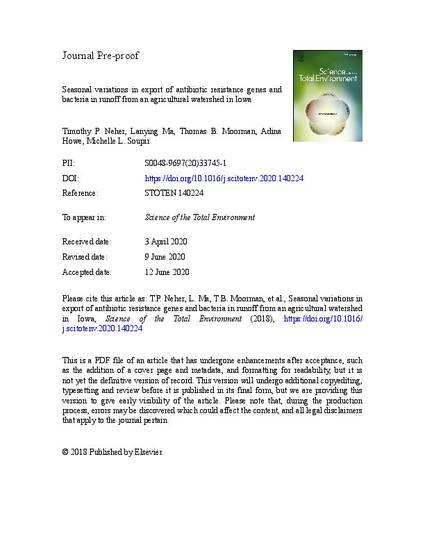
Seasonal variations of antimicrobial resistance (AMR) indicators in runoff water can help improve our understanding of AMR sources and transport within an agricultural watershed. This study aimed to monitor multiple areas throughout the Black Hawk Lake (BHL) watershed (5324 ha) in central Iowa during 2017 and 2018 that consists of both swine and cattle feeding operations as well as known areas with manure application. The measured indicators included plate counts for fecal indicator bacteria (FIB) E. coli, Enterococcus, antibiotic resistant fecal indicator bacteria (ARBs) tylosin resistant Enterococcus, tetracycline resistant Enterococcus, and antibiotic resistance genes (ARGs): ermB, ermF (macrolide), tetA, tetM, tetO, tetW (tetracycline), sul1, sul2 (sulfonamide), aadA2 (aminoglycoside), vgaA, and vgaB (pleuromutilin). Both the plate count and the ARG analyses showed seasonal trends. Plate counts were significantly greater during the growing season, while the ARGs were greater in the pre-planting and post-harvest seasons (Wilcoxon Rank-Sum Test p < 0.05). The ermB gene concentration was significantly correlated (p < 0.05) with E. coli and Enterococcus concentrations in 2017, suggesting a potential use of this ARG as an indicator of environmental AMR and human health risk. Flow rate was not a significant contributor to annual variations in bacteria and AMR indicators. Based on observed seasonal patterns, we concluded that manure application was the likely contributor to elevated ARG indicators observed in the BHL watershed, while the driver of elevated ARB indictors in the growing season can only be speculated. Understanding AMR export patterns in agricultural watersheds provides public health officials knowledge of seasonal periods of higher AMR load to recreational waters.
Available at: http://works.bepress.com/michelle_soupir/89/

This is a manuscript of an article published as Neher, Timothy P., Lanying Ma, Thomas B. Moorman, Adina Howe, and Michelle L. Soupir. "Seasonal variations in export of antibiotic resistance genes and bacteria in runoff from an agricultural watershed in Iowa." Science of The Total Environment (2020): 140224. DOI: 10.1016/j.scitotenv.2020.140224.